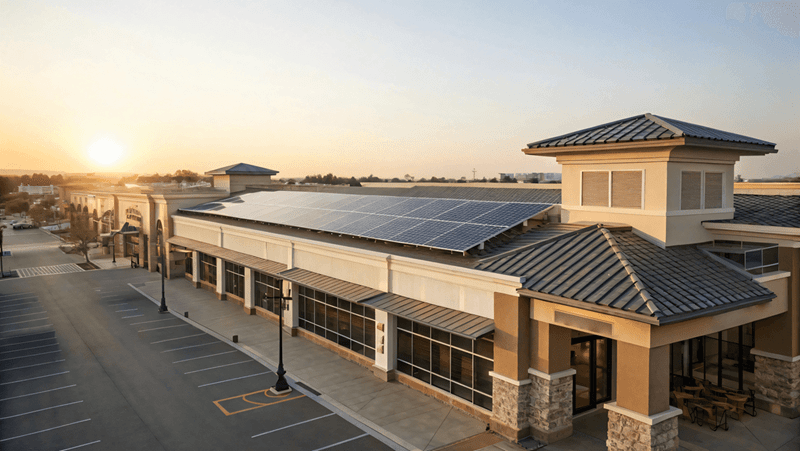
Energy news - May 2025
- Private wire development opportunities
- The UK Government’s Planning and Infrastructure Bill
- UK grid connection reforms update
- New starters
- Planning and technical updates
- Energy market update
- Upcoming events
Private wire development opportunities
It is likely that many of you will have seen the recent news of significant power blackouts in Spain and Portugal when their grid system failed. Whilst such events are thankfully very rare, such outages can happen when you have such highly centralised electrical grid systems like those in Spain. Here in the UK, we have a similar, heavily centralised energy distribution grid network but are seeing an increasing demand for more localised electricity generation and supply.
“Private wire”, “behind the meter” or more simply, decentralised energy networks are those where organisations, homeowners, estates and landowners install technologies like solar PV or wind turbines to power their homes and businesses directly. The green electricity is generated on or near to site and is connected directly to where the power is needed. These private wire developments can be installed on existing rooftops or adjoining suitable land, either in the form of greenfield development or potentially making innovative use of parking areas by building things like solar car ports and associated EV charging stations.
On site generation in this form avoids such reliance on a centralised grid supply system, provides security of supply and gives less exposure to those risks highlighted by the events in Spain recently. Adding smart grids and energy storage technologies can create additional flexibility and even greater energy autonomy.
With the current Governments drive for NetZero, such schemes can make huge contributions to sustainability goals and reduce the carbon footprint of even large energy consumers.
At Carter Jonas we have developer clients who are experts in the design and deployment of behind the meter projects. For projects of sufficient scale (usually a few hundred kilowatts up to tens of megawatts), these organisations offer fully funded development solutions where there is no upfront cost and the developer takes the entirety of the project risk. This is paid for through a long-term power purchase agreement (PPA) which is the contract between the developer and the off taker of the electricity. PPA’s are usually for a period of around twenty years and offer a fixed index linked price rate on a pence / kW basis, usually at a much lower price than current grid connected supply agreements.
Private wire developments offer increased sustainability with NetZero in mind, long term energy security at often lower prices and protects businesses against rising energy costs with those fixed price PPA arrangements.
If you are a high energy user, a business with a flat or gently pitched roof system or available bare ground that wants to reduce your electricity costs or a landowner with land adjoining manufacturing or industrial premises and are interested in finding out more, please get in touch with Simon Tarr or Stuart Campbell.
The UK Government’s Planning and Infrastructure Bill: A catalyst for economic growth and clean energy
The UK Government recently introduced the Planning and Infrastructure Bill to parliament, aiming to kickstart economic growth and establish Britain as a clean energy powerhouse.
This Bill focusses on streamlining the planning process primarily in England and Wales, with some provisions extending to Scotland. The goal is to expedite the consenting regime for developing new homes and infrastructure.
Key highlights for infrastructure development:
- Pre-application and proportionality
Simplifying initial stages of the consenting regime to ensure efficient and proportional planning. Provisions include streamlining consultation requirements for nationally significant infrastructure projects.
- Targeted threshold
Applying specific thresholds to different types of nationally significant infrastructure development.
- Regular updates to the National Policy statements
Reflecting current needs and priorities to provide more clarity from national guidelines.
- Community benefits
A new funding mechanism introduced to infrastructure developers so communities can gain from the network infrastructure being sited in their vicinity.
- Compulsory purchase reform
Unlocking land for large-scale investments through reforms in compulsory purchase processes.
- Joined-up approach
Introducing a coordinated strategy to meet infrastructure needs across local planning authority areas.
These reforms are designed to create a more efficient and sustainable development framework, supporting the UK’s ambitions for economic growth and clean energy leadership.
The Carter Jonas consenting team works across a range of infrastructure projects, both large and small scale, and as diverse as new electricity lines, roads, railways and water schemes.
UK grid connection reforms update
The UK’s electricity grid connection process is presently undergoing a transformative reform to support the country's transition to net-zero. At the core of this overhaul is the Gate 2 process, led by the National Electricity System Operator (NESO), which is part of the broader Targeted Model Option 4+ (TMO4+) reform package, which was approved by Ofgem on April 15, 2025. The purpose of this new framework is to eliminate connection delays and to ensure that renewable energy projects such as solar and batteries, that are meeting the development criteria are prioritised.
Previously, the grid connection process operated on a "first come, first served" basis, this resulted in a great number of speculative projects and “zombie” projects that delayed more viable ones which are further behind in the connection queue. Under the new system, Ofgem has approved a much-needed shift to a "first ready and needed, first connect" approach. On 15 April 2025, Ofgem formally endorsed the TMO4+ reform package, initiating a 56-day standstill period which comes to an end on 10 June 2025. After this, developers will have four weeks' notice ahead of the application windows opening for Gate 2 submissions.
The Gate 2 process will introduce stricter criteria for securing firm grid connection offers. Projects must demonstrate readiness, for instance by securing planning consent, and must align with strategic priorities, including the UK’s Clean Power 2030 Action Plan. If an existing project meets the Gate 2 criteria and demonstrates readiness, they will retain their existing grid connection date or may receive an accelerated connected date depending on any changes to the queue. If projects fail to meet these standards, they may be placed into Gate 1, where they will receive only indicative connection offers without guaranteed timelines and may lose their existing queue position.
A critical new feature is the Progression Commitment Fee (PCF), an escalating fee which will penalise generation projects that have progressed to the Gate 2 connections queue but have yet to submit a planning application. This fee starts at £2,500 per MW and will rise by the same amount every 6 months until a cap of £10,000 per MW is reached. This fee is designed to discourage speculative applications by charging projects that don’t reach development milestones within set timeframes.
According to the new schedule, the Gate 2 application window for distribution-connected projects opens in May 2025, followed by transmission-connected projects on 8 July 2025. NESO will begin notifying developers of their project's status in September 2025, with revised firm connection offers issued from Autumn, starting with projects targeted for connection in 2026 and 2027.
These changes mark a pivotal moment in the evolution of the UK’s electricity infrastructure. With an increased focus on deliverable projects, the Gate 2 reforms are expected to significantly accelerate grid access for viable clean energy projects meeting the development criteria and support the nation’s broader decarbonisation strategy.
New starters

Simon Tarr, who joins Carter Jonas from Pegasus Group, where he was Senior Director of Land & Property, will focus on supporting the national Energy team. With over 25 years in providing land and property services, Simon has a proven track record in the energy, telecoms, and commercial development sectors. His previous roles have included Head of Land at Engie, where he successfully managed renewable energy development projects across the UK and Ireland.
Working closely with the firm’s Head of Energy, Charles Hardcastle and Head of Transactions, Stuart Campbell, he will support the implementation of innovative strategies that resonate with clients and stakeholders to enhance Carter Jonas' reputation as a trusted advisor in energy developments including site acquisition and management.
Planning and technical updates
Grid – Gate 2 (connections reform)
On the 15 April 2025 Ofgem made their decision on the Connections Reform Package (TM04+). This decision announced a 56-day standstill period for the licence changes, followed by an additional 4 weeks as required by the new CUSC requirements. This will mean the Gate 2 evidence submission window for transmission connecting customers will open in July 2025 and for distribution customers in May 2025.
This reform will prioritise projects that are strategically aligned and ready-to-build and should unlock capacity for projects that will reach fruition. These deadlines could pose a near-term risk for schemes that are less advanced, which may lose queue positions or face delays – meaning there is a far greater need for early-stage planning and investment.
Capacity market amendments
The Department for Energy Security and Net Zero (DESNZ) requested the Subsidy Advice Unit (SAU) to review the proposed changes to the Capacity Market scheme, which was first introduced in 2014. On the 28 March 2025, the SAU published this report. The SAU found the proposed changes by DESNZ were well evidenced and address key risks but recommend further analysis of the Capacity Market scheme’s ongoing impact on competition and investment, particularly in the wholesale and balancing markets.
Zonal pricing proposals
Zonal pricing aims to reflect regional electricity supply and demand, for instance for those with houses or businesses in areas close to renewable generators, they will have energy available to them at a lower cost than those situated a long way from the source of energy. potentially reducing system costs. This proposal has however been criticised by many. The UK Energy Research Centre (UKERC) believe that it could lead to an increase in Contract for Difference (CfD) strike prices due to uncertainty, which could then result in an increase to energy consumers by as much as £3 billion. Whilst it could improve long-term efficiency it would likely pose serious near-term risks to investor confidence and consumer bills if introduced prematurely.
Long Duration Energy Storage (LDES) proposals
Ofgem has launched a cap and floor revenue support scheme to unlock investment for new LDES projects. This follows the consultation process which took place in October 2024. The scheme will offer investors a minimum revenue and will cap profits once they reach a certain level, thus incentivising funding. Developers with eligible projects – offering at least eight hours of continuous storage – can now apply, with the first funding awards expected by Q2 2026. It will support a range of technologies from pumped hydro to lithium-ion. The hope is for the scheme to overcome barriers to LDES deployment, such as high upfront costs and to thus grow the market.
Hydrogen projects being supported
The UK government has selected 27 hydrogen projects totalling 875 MW for the next stage of the Second Hydrogen Allocation Round (HAR2). This is expected to create thousands of jobs and to draw in £1 billion of private sector investment into the UK by 2029.
Solar canopy mandate (UK)
The UK government is seeking feedback on a proposal to mandate the installation of solar canopies on new outdoor carparks. They are also asking for feedback relating to how current planning policies relate to EV charging infrastructure, as transport remains the largest emitting sector for greenhouse gases.
Energy market update
Since a spike in markets in mid-February, we have seen both gas and power prices fall back to levels seen at the start of winter. This bearish movement in energy commodities has been largely fuelled by economic concerns and a drop in demand. Gas demand in the UK has been 10% below the seasonal average in recent weeks as a result of the warm weather. There has also been a positive start to the gas storage injection season for the winter periods which has helped pressure gas prices down further.
On the 28 April, the worst blackout in two decades occurred when supply to most of the Iberian Peninsula was cut for almost 24 hours, leading to speculation as to the, as yet undetermined, cause of the outage which affected around 55 million people in Spain and Portugal. Outside of Spain and Portugal, the impact on markets was mainly confined to the French short-term market.
We are expecting prices will remain bearish over the summer months; therefore, we would recommend any high users of electricity or gas to consider renewing now for any contracts ending in 2025 or 2026. To discuss options, please contact Helen Moffat.









